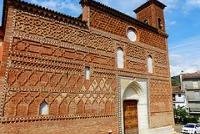
I visited this WHS in May 2014. I visited 4 out of the 5 localities included in this WHS and I visited 6 out of the 10 outstanding Mudejar buildings mentioned by UNESCO. In Zaragoza, I visited all 3 sites and I must say that the interior of the Aljafería Palace was my favourite. I haven't visited Granada and Alhambra yet so I'm glad I visited this site before which surely helped me appreciate its beauty even more. The La Seo Cathedral costs 3 euros to visit however there isn't much Mudejar architecture left to see inside. Nonetheless, if you're not pressed for time, do visit as there is an interesting tapestry collection displayed inside. The Mudejar architecture of La Seo is clearly visible on the lateral side just beside the Diocesan Museum. The Church of San Pablo too is best viewed from the outside from where you can gaze at the ornate brickwork on the bell tower. Zaragoza offers more Mudejar sites other than those mentioned by UNESCO which I visited during the 2 days I spent here. Obviously you cannot miss the huge Basilica of Our Lady of Pilar and on one of the tall church towers opposite the Ebro river bank you can go up a lift to enjoy an amazing view of all the spires in Zaragoza as well as the several bridges on the Ebro river. A few photo tips: best light for the panoramic view from the Basilica is late afternoon; same applies for the La Seo Cathedral and San Pablo Church. The best light for the Aljafería Palace entrance with all the towers is in the morning. Had I visited only Zaragoza I would concluded that this WHS is interesting and worth visiting but nothing very special on the whole. However, after I spent a couple of days driving around the province of Calatayud, I really could appreciate the magnitude and importance of this WHS. Perhaps the city of Calatayud itself doesn't offer enough of a wow effect as it only offers a sort of continuation of the Mudejar architecture visible in Zaragoza. Again, apart from the beautifully ornate brickwork on the tall tower of the Collegiate Church of Santa Maria, there are quite a lot of other Mudejar buildings to visit and most of them have white storks nesting on them. Once I drove out of the city of Calatayud and stopped to take a photo of the panoramic view of the city with all its spires and towers against a background of rolling hills, the landscape changed completely and it become much more picturesque and desolate at the same time. The remote villages of the Calatayud province turned out to be a real treat! I had a great time driving from one small village to the next, each offering splendid examples of Mudejar architecture - with the highlight being the brick fort churches. Online I found a very informative and useful website with an interactive map of Aragon showing all the Mudejar highlights in every province (http://www.aragonmudejar.com/mapgen/general.htm). After checking out the interactive map of the province of Calatayud, I decided to visit the Church of Santa Tecla in Cervera de la Cañada first. Although the local people there are very friendly, I cannot understand why UNESCO highlighted this church over others nearby. Don't get me wrong, I'm glad I visited, but I would recommend spending more time exploring other nearby villages which have better examples of Mudejar architecture such as the Church of Our Lady of Castillo in Aniñón or the Church of San Felix in Torralba de Ribota where you can find a few information boards present and also a UNESCO plaque present. After a long winding drive I finally got to the remote village of Tobed where I visited the Church of Santa Maria which is rightly mentioned by UNESCO as one of the best example of Mudejar architecture in Aragon (photo). Having visited all these sites and knowing that these are just the best examples of Mudejar architecture in Aragon, I really got to appreciate the OUV of this WHS and the fusion of Christian and Islamic art styles. Hopefully, I will get to visit Teruel in the near future when I visit Valencia.
More on
Comments
No comments yet.
